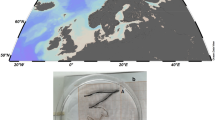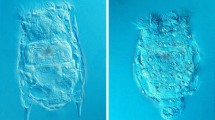Abstract
The brown alga Fucus ceranoides L. was studied in several estuaries on the Isle of Man (Great Britain) in the summers of 1989 and 1990. The objective were to determine the success of natural fertilization in a dioecious organism with external fertilization and to contribute to our understanding of processes such as polyspermy blocks and propagule settlement under natural conditions. Gamete release occurred on a semilunar cycle near full and new moons; at such times, settlement densities of 500 zygotes cm-2 d-1 were common. Gamete release was largely restricted to daytime high tides. Fertilization success was high: about 95 to 100% of all eggs released were fertilized, and 1 to 9% of these zygotes were polyspermic. The incidence of polyspermy increased towards the upper limit of F. ceranoides in the estuary of the river Neb; this may be significant in the context of the Na+-dependent block against polyspermy. Levels of polyspermy were not related to fertilization success (R2=0.06). Rates of pronuclear migration and karyogamy determined in the laboratory were used as an internal clock to estimate when eggs were fertilized in the field. Most eggs were fertilized 30 to 120 min after plants were immersed by the incoming tide, which corresponded to the period 60 min before to 30 min after high tide. The high success of fertilization suggests that polyspermy blocks are important in nature, and, in combination with the high settlement of zygotes, shows that population size in F. ceranoides is determined by post-settlement mortality, not by propagule availability.
Similar content being viewed by others
Literature cites
Austin, C. R., Braden, A. W. H. (1953). An investigation of polyspermy in the rat and rabbit. Aust. J. biol. Sci. 6: 674–692
Braden, A. W. H., Austin, C. R., David, H. A. (1954).The reaction of the zona pellucida to sperm penetration. Aust. J. biol. Sci. 7: 391–409
Brawley, S. H. (1987). A sodium-dependent, fast block to polyspermy occurs in eggs of fucoid algae. Devl Biol. 124: 390–397
Brawley, S. H. (1991). The fast block against polyspermy in fucoid algae is an electrical block. Devl Biol. 144: 94–106
Brawley, S. H., Johnson, L. E. (1991) Survival of fucoid embryos in the intertidal zone depends upon developmental stage and microhabitat. J. Phycol. 27: 179–186
Bunning, E., Müller, D. (1961). Wie messen Organismen lunare Zyklen? Z. Naturf. 16B: 391–395
Burrows, E. M. (1963). Ecological experiments with species of Fucus. Proc. 4th int. Seaweed Symp. (Biarritz, 1961) 4: 166–170 [Virville, de D., Feldmann, J. (eds). Pergamon Press, London]
Chapman, A. R. O. (1986). Population and community ecology of seaweeds. Adv. mar. Biol. 23: 1–161
Denny, M. W., Shibata, M. F. (1989). Consequences of surf-zone turbulence for settlement and external fertilization. Am. Nat. 134: 859–889
Dix, T. G. (1969). Aggregating in the echinoid Evechinus chloroticus. Pacif. Sci. 23: 123–124
Dragesund, O., Gjosaeter, J., Monstad, T. (1973).Estimates of stock size and reproduction of the Barents Sea capelin in 1970–1972. FiskDir. Skr. (Ser. Havunders). 16: 105–139
Fletcher, R. L. (1980). Studies on the recently introduced brown alga Sargassum muticum (Yendo) Fensholt. III. Periodicity in gamete release and “incubation” of early germling stages. Botanica mar. 23: 525–432
Goudeau, H., Goudeau, M. (1989). Electrical responses to fertilization and spontaneous activation in decopod crustacean eggs: characteristics and role. In: Nuccitelli, R., Cherr, G. N., Clark, W. H., Jr. (eds.) Mechanisms of egg activation. Plenum Press, New York, p. 61–88
Howell, B. R., Child, A. R., Houghton, R. G. (1989). Fertilization rate in a natural population of the common sole (Solea solea L.). Rapp. P.-v. Réun. Cons. int. Explor. Mer 191: 441
Hsiao, S.-M., Meier, A. H. (1989). Comparison of semilunar cycles of spawning activity in Fundulus grandis and F. heteroclitus held under constant laboratory conditions. J. exp. Zool. 252: 213–218
Johannes, R. E. (1978). Reproductive strategies of coastal marine fishes in the tropics. Envir. Biol. Fish. 3: 65–84
Khfaji, A. K., Norton, T. A. (1979). The effects of salinity on the distribution of Fucus ceranoides. Estuar. cstl. mar. Sci. 8: 433–439
Kjesbu, O. S. (1989). The spawning activity of cod, Gadus morhua L. J. Fish Biol. 34: 195–206
Korringa, P. (1947). Relations between the moon and periodicity in the breeding of marine animals. Ecol. Monogr. 17: 347–381
Lüning, K. (1981). Egg release in gametophytes of Laminaria saccharina: induction by darkness and inhibition by blue light and U.V.. Br. phycol. J. 16: 379–393
Lynn, J. W., Clark, W. H., Jr. (1983). A morphological examination of sperm-egg interaction in the freshwater prawn, Macrobrachium rosenbergii. Biol. Bull. mar. biol. Lab., Woods Hole 164: 446–458
May, D. I., Clayton, M. N. (1991). Oogenesis, the formation of oogonial stalks and fertilization in Sargassum vestitum (Fucales, Phaeophyta) from southern Australia. Phycologia 30: 243–256
Menge, B. A., Sutherland, J. P. (1987). Community regulation: variation in disturbance, competition and predation in relation to environmental stress and recrutment. Am. Nat. 130: 730–757
Mills, C. E. (1983). Vertical migration and diel activity patterns of hydromedusae: studies in a large tank. J. Plankton Res. 5: 619–635
Miyazaki, S.-I., Hirai, S. (1979). Fast polyspermy block and activation potential: correlated changes during oocyte maturation of a starfish. Devl Biol. 70: 327–340
Moore, P. G., Seed, R. (eds.) (1986). The ecology of rocky coasts. Columbia University Press, New York
Mortensen, T. (1938). Contributions to the study of the development and larval forms of echinoderms. IV. K. danske Vidensk. Selsk. Skr. Naturvidensk. Math. Afd. 9.4: 1–39
Neumann, D. (1989). Circadian components of semilunar and lunar timing mechanisms. J. biol. Rhythms 4: 285–294
Ngan, Y., Price, I. R. (1980). Seasonal growth and reproduction of intertidal algae in the Townsville region (Queensland, Australia). Aquat Bot. 9: 117–134
Ngan, Y., Price, I. R. (1983). Periodicity of spore discharge in tropical Florideophyceae (Rhodophyta). Br. phycol. J. 18: 83–95
Nichols, J. H. (1989). The diurnal rhythm in spawning of plaice (Pleuronectes platessa L.) in the southern North Sea. J. Cons. Ciem. 45: 277–283
Pearse, J. S., McClary, D. J., Sewell, M. A., Austin, W. C., Perez-Ruzafa, A., Byrne, M. (1988) Simultaneous spawning of six species of echinoderms in Barkley Sound, British Columbia. Invert. Reprod. Dev. 14: 279–288
Pennington, J. T. (1985). The ecology of fertilization of echinoid eggs: the consequences of sperm dilution, adult aggregation, and synchronous spawning. Biol. Bull. mar. biol. Lab., Woods Hole 169: 417–430
Picken, G. B., Allan, D. (1983). Unique spawning behaviour by the Antarctic limpet Nacella (patinigera) concinna (Strebel, 1908). J. exp. mar. Biol. Ecol. 71: 283–287
Smith, G. M. (1947). On the reproduction of some Pacific Coast species of Ulva. Am. J. Bot. 34: 80–87
Starr, M., Himmelman, J. H., Therriault, J.-C. (1990). Direct coupling of marine invertebrate spawnng with phytoplankton blooms. Science, N.Y. 247: 1071–1074
Stoner, D. (1990). Recruitment of a tropical colonial ascidian: relative importance of pre-settlement versus post-settlement processes. Ecology 71: 1682–1690
Summerfelt, R. C., Hall, G. E. (1987). Age and growth of fish. Iowa State University Press, Ames
Taylor, M. H. (1984).Lunar synchronization of fish reproduction. Trans. Am. Fish. Soc. 113: 484–493
Thorson, G. (1950). Reproductive and larval ecology of marine invertebrates. Biol. Rev. 25: 1–45
Umamaheswara Rao, M., Kaliaperumal, N. (1987). Diurnal periodicity of spore-shedding in some red algae of Visakhapatnam coast. J. exp. mar. Biol. Ecol. 106: 193–199
Underwood, A. J., Fairweather, P. G. (1989). Supply-side ecology and benthic marine assemblages. Trends Ecol. Evol. 4: 16–20
Victor, B. C. (1982). Daily otolith increments and recruitment in two coral-reef wrasses Thalassoma bifasciatum and Halichoeres bivittatus. Mar. Biol. 71: 203–208
Wittmann, W. (1965). Aceto-iron-haematoxylin-chloral hydrate for chromosome staining. Stain Technol. 40: 161–163
Yund, P. O. (1990). An in situ measurement of sperm dispersal in a colonial marine hydroid. J. exp. Zool. 253: 102–106
Author information
Authors and Affiliations
Additional information
Communicated by J. Grassle, New Brunswick
Rights and permissions
About this article
Cite this article
Brawley, S.H. Fertilization in natural populations of the dioecious brown alga Fucus ceranoides and the importance of the polyspermy block. Marine Biology 113, 145–157 (1992). https://doi.org/10.1007/BF00367648
Accepted:
Issue Date:
DOI: https://doi.org/10.1007/BF00367648




